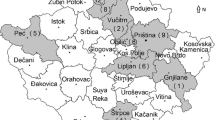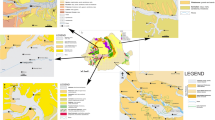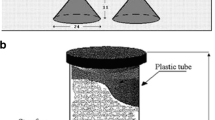Abstract
High indoor radon concentrations in a uranium-radium low-level area in the Eifel region, Germany, near the village of Döttingen are caused by ascending radon migration following the convection of groundwater and soil gas along pathways (fractures and faults) in the bedrock sediments of Lower Devonian age. Positive radon anomalies in the soil gas are found to coincide with the locations of houses showing the highest concentrations. These houses are older buildings without concrete foundation slabs. Normally radon concentrations in soil gas are highly correlated with the values of emanated radon calculated on the basis of radium content in the surrounding soils and rocks (diffusive radon potential). However, close to zones of tectonic fractures and faults around the maar-type volcano of Döttingen abnormally high radon concentrations, which were transported by circulating groundwater and postvolcanic exhalation of CO2 (convective radon potential) were detected.
Similar content being viewed by others
References Cited
Barretto, P. M. C., 1975, Radon-222 emanation characteristics of rocks and minerals: Radium in uranium mining, IAEAPL-565/1, p. 129–150.
Bundesminister des Innern, 1985, Radon in Wohnungen und im Freien. Erhebungsmessungen in der Bundesrepublik Deutschland: Bericht BMI, Bonn, 82 + 30 pp.
Folkerts, K. H., G. Keller, and H. Muth, 1982, Method for the determination of222Rn (radon)- and220Rn (thoron)-exhalation rates using alpha-spectroscopy: Radiation Protection Dosimetry, v. 3, no. 1/2, p. 83–89.
Folkerts, K. H., G. Keller, and H. Muth, 1984, An experimental study on diffusion and exhalation of222Rn and220Rn from building materials: Radiation Protection Dosimetry, v. 9, no. 1, p. 27–34.
Israel, H., and S. Björnsson, 1967, Radon and thoron in soil air over faults: Zeitschrift für Geophysik, v. 33, p. 48–64.
Jacobi, W., 1986, Lungenkrebs nach Bestrahlung: Das Radon-Problem: Naturwissenschaften 73, p. 661–668.
Käppler, R., 1984, Integrierende Radonmessungen mittels Festkörperspurdetektoren für die Lösung ausgewählter ingenieurgeologischer Probleme: Freiberger Forschungshefte, Serie C, v. 392, 129 pp.
Keller, G., and M. Schütz, 1988, Radon exhalation from the soil: Radiation Protection Dosimetry, v. 24, no. 1/4, p. 43–46.
Stachel, T., and G. Büchel, 1989, Das Döttinger Maar: Fallstudie eines grossen tertiären(?) Tuffschlotes im Vulkanfeld der Hocheifel: Zeitschrift der Deutschen Geologischen Gesellschaft v. 140, p. 35–51.
Tanner, A. B., 1989, Error in measuring radon in soil gas by means of passive detectors: EOS, American Geophysical Union Trans. Vol. 70, p. 497.
Author information
Authors and Affiliations
Rights and permissions
About this article
Cite this article
Keller, G., Schneiders, H., Schütz, M. et al. Indoor radon correlated with soil and subsoil radon potential—a case study. Environ. Geol. Water Sci 19, 113–119 (1992). https://doi.org/10.1007/BF01797439
Issue Date:
DOI: https://doi.org/10.1007/BF01797439




